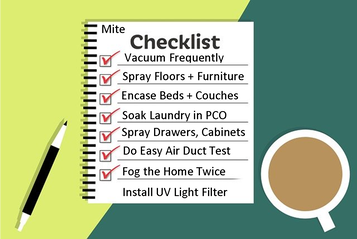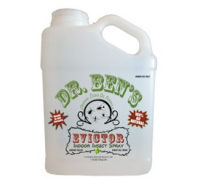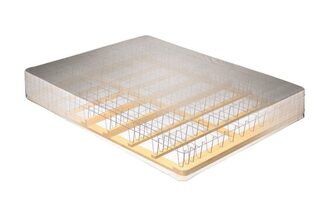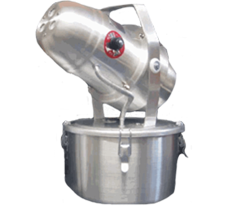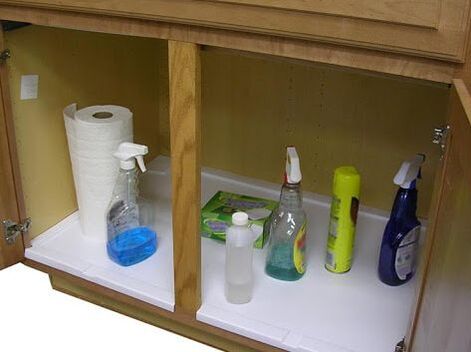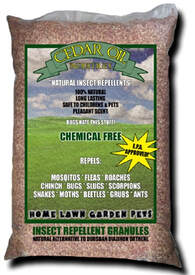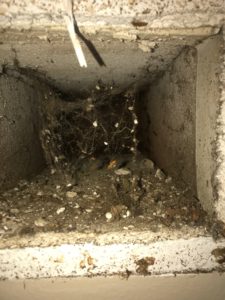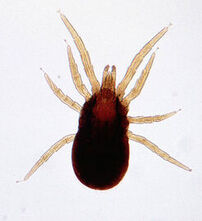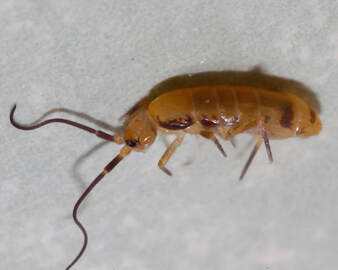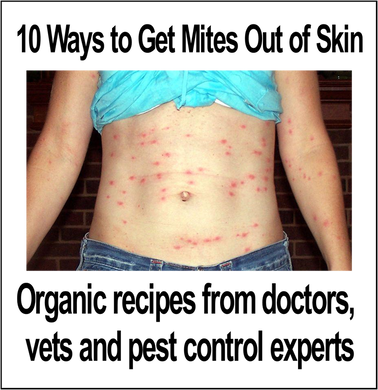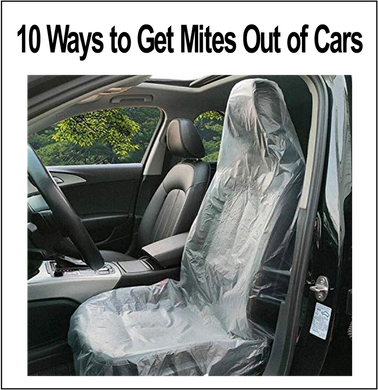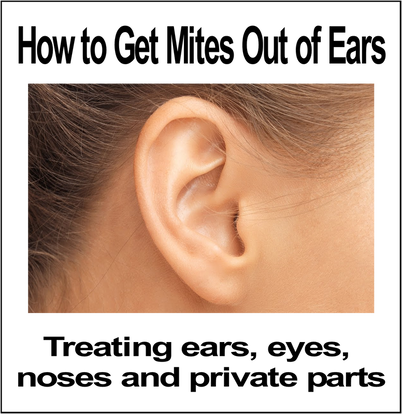Mite Control Checklist - Top 20 Things You Must Do
Start with Dr. Ben's Evictor - You'll need one gallon per 1,000 square feet.
|
1. Clear junk. Here's a list of things that mite warriors should discard or put in storage.
- Throw Rugs Rugs make it difficult to spray, vacuum and perform daily maintenance rituals connected to mite eradication.
- Throw Pillows Mites can burrow deep into fabric items. It's impossible to kill them without soaking the item in pesticides.
- Cardboard Boxes Mites can EASILY get in and out of cardboard boxes. Store all of your extra items in air tight plastic bins.
- Live Plants Depending on what type of micro tiny invader is bothering you, it may like to eat decaying leaves or breed in the soil.
- Old Clothes! Unless you plan on soaking old clothes in PCO and storing them in PLASTIC air tight containers, get them out of your life.
- Wicker Laundry Baskets. Mites can easily move in and out of the spaces. Store dirty and clean laundry in air tight plastic bins.
- Old Toys. Since toys should be sterilized on a regular basis, now is a good time to get old or unwanted items out of the mix.
- Pictures. Did you know that mites can hide behind wall hangings and escape the effects of fogging? Put your favorite pieces in storage until you're absolutely certain that the mites in your home are gone. If that means storing your favorite paintings for a year or more, so be it.
2. Vacuum thoroughly, spray carpets and clean hard floors with Dr. Ben's Evictor.
Vacuuming will remove stray bugs on the surface and loosen sticky eggs hidden within carpet fibers. To clean wood or vinyl floors, saturate a dry Swiffer pad with the Evictor. You may also use a clean sponge mop or rag to spread the treatment over the floor.
3. Spray both sides of your mattress and box springs. Spray all parts of the frame and headboard.
4. Spray under beds and between furniture with Dr. Ben's Evictor. Allow to dry.
|
If your bed is too heavy to move alone, invest in a pump sprayer with an extra long applicator. Link to Long Arm Sprayer: https://amzn.to/4bhxpOz We can't always move furniture to refresh treatments on a daily basis. Don't allow micro tiny critters to breed and flourish in places you can't reach, especially in the bedroom. Get control of the situation now.
|
5. Dust under beds and furniture with diatomaceous earth. Here's why:
Link to Diatomaceous Earth: https://amzn.to/3JDXnjQ It's difficult to refresh spray treatments under beds and furniture on weekly basis. If you apply diatomaceous earth to hard-to-reach areas, it will keep protecting the area from all types of insects for years to come. Use DE under beds, dressers, couches and other spaces that are hard to reach. The brand linked above comes with a handy puffer that will allow you to blow the powder into tight spaces, such as gaps between appliances. Important: Do not spread large amounts of diatomaceous earth over open floors and high traffic areas, as this substance can be like fiberglass when it becomes airborne. It's best to keep the dust contained under beds, couches and furniture. It can also be applied along baseboards. Diatomaceous earth is considered to be safe when used judiciously. In other words, don't get carried away. A light dusting is all you need. For extra small crevices, consider buying an applicator bottle with a specialized tip: Link to Pointed Applicator Tip: https://amzn.to/3y27BaR
6. Enclose your mattress in a PROPER waterproof encasement labeled for dust mites.
Link to Mattress Encasement: https://amzn.to/3y2ftJu Mites don't just linger on the surface of your bed. They can hide deep within the mattress where spray pesticides can't reach them. Critters like bird and rodent mites can keep emerging from hidden areas to attack. Encasing your mattress will ensure that hidden mites can't come back to harm you. The link above leads to one of my favorite encasement brands. The smooth fabric doesn't feel like plastic against the skin. There's a PVC free and vinyl free waterproof backing that helps the encasement resist leakage. If you'd prefer to shop local stores for an encasement, be sure it's a waterproof encasement certified for bedbug and dust mite protection. If your current encasement doesn't feel like it's containing the problem well enough, DOUBLE ENCASE YOUR MATTRESS.
7. Protect bed legs with a mite and bedbug interceptor.
Link to Mite and Bedbug Interceptor: https://amzn.to/3xXlJlV Bedbug interceptors are designed to catch bedbugs on their journey from the floor to the host. Such devices can also be used to catch crawling mites. Fill the outer chamber with diatomaceous earth. Note: Interceptors will only be effective against crawling organisms such as bird and rodent mites. Springtails are jumpers. They can catapult right past the interceptor and make direct contact with your bed frame.
8. Move beds at least six inches from the walls, nightstands and dressers.
This will ensure that mites crawling up the wall can't easily transfer to your bed. Your bed should not touch nightstands, storage chests or bedside tables.
9. Use single layer synthetic blankets. No cotton and no comforters!
Example of 100 Percent Synthetic Blanket: https://amzn.to/3y1YFCm MItes love cotton and natural materials. They also love to nest inside comforters. Avoid any type of blanket that features two layers of fabric stuffed with cotton, down or any other natural materials. Mites can infest between those layers to insulate themselves and survive a trip through the washing machine. To kill mites embedded between the layers of thick blankets, soak comforters in Borax overnight. If Borax doesn't do the trick on its own, add two cap fulls of our Nature's Defender PCO Concentrate. Store comforters in air tight plastic containers, and don't return them to the bed until you're 100% sure that your home is no longer infested. It's wise to choose SINGLE LAYER blankets made of synthetic materials such as rayon or polyester. Most plush blankets are made of synthetic materials. Read tags to be sure you're not purchasing organic materials like wool or cotton.
10. Spray couches and easy chairs with Dr. Ben's Evictor. Fog into spring cavity.
|
Spray every inch, including sides, back, seats and bottom. For leather or vinyl couches, you may saturate a rag with Dr. Ben's Evictor and wipe the surface clean. If you have a fog machine, it's a good idea to flip the couch upside down and fog into the cavity. Most couches have a thin layer of fabric stapled across the bottom. Remove this fabric point the nozzle of the fog machine into the spring cavity.
|
11. Enclose couches and recliners in furniture bags.
Link to Furniture Bags: https://amzn.to/3weei9t Parasites, including mites and bedbugs, will often congregate deep inside the couch crevices where wallets and keys get lost. That means many mites will be untouched when you spray the surface of your furniture with pesticides. In addition to spraying the surface, flip your couch upside down, tear off the protective covering and fog into the cavity of the couch. After fogging, Insert your couch into a giant furniture storage bag and keep the bag sealed. The length of time you'll need to keep it in the bag will depend on the type of mite you have, as some types of mites can live for extended periods without a blood meal. For example, a rodent mite can only live about a month without a blood meal. A bird mite can live nine months without feeding.
12. Spray inside cabinets and drawers, especially under sinks.
|
Yes, it's important to remove dishes, utensils and clothes from cabinet drawers before spraying. Yes, you should spray pantry cabinets, even if you're not dealing with notorious pantry dwellers like grain mites. If your infestation is connected to springtails, this is a beautiful place to set glue traps baited with mold. Visit our trapping page for further details.
|
13. Make poison bait to put under sinks, especially if you're dealing with springtails.
Link to Main Bait Ingredient: https://amzn.to/3whDCv6
Directions to Make Bait: Combine 1/4 tablespoon of boric acid powder with 1 tablespoon of white flour, 1 tablespoon of sugar and a pinch of yeast. Add just enough water to turn the mixture into dough. Pinch off little pieces of dough and place the sticky balls near the middle of a glue board made for spiders. Study your glue boards with a magnifying glass each day. If springtails actually eat the bait/attractant, they'll die. However, the glue board should prevent them from getting to the bait unless they jump straight onto it. Note that boric acid and Borax aren't the same product. It's important to use boric acid when mixing bait. Borax is the basic mineral mined from the ground. A refining process turns it into boric acid. Boric acid is more powder like and more "absorbable" through digestion. Be very careful if you have pets or small children who might eat the bait by accident. Open baiting techniques aren't advised for homes with pets and toddlers.
14. Soak infested laundry in a proper organic pesticide - Nature's Defender PCO Choice.
|
For more than 20 years, pet owners and veterinarians have trusted this product to wash and soak animals afflicted with mites. Link to Nature's Defender PCO Choice: https://www.wholesalepesticides.com/shop-online/outdoor-pest-control/ The formula can also be added to laundry water to help kill mites in the wash. Detergents and hot water alone don't always kill parasites in the laundry. When scabies outbreaks occur in nursing homes and other institutions where bedridden patients have no skin-to-skin contact, the laundry is usually blamed for transmission. Over a fifteen year period, I have received thousands of phone calls from frustrated callers who claim that they can feel things pricks and movement coming from parasites like bird mites or springtails in laundered clothing that comes straight out of the dryer. As a general rule, infested laundry should be soaked for an hour before washing. A cap full of Vet's Choice Concentrate can be added along with the Borax. When soaking thick items such as blankets and sweaters, add two caps of the concentrate.
|
15. Story dirty laundry in plastic bins. Add sachet bags filled with cedar granules.
|
Avoid storing dirty laundry in wicker hampers, as mites can easily escape through gaps in the material. Store laundry in plastic storage bins with lids that snap or lock into place. To control parasites within the container, fill organza bags with cedar granules and drop them into the container. Link to Sachet Bags: https://amzn.to/49WMTH0 Link to Granules: https://www.wholesalepesticides.com/shop-online/outdoor-pest-control/
|
16. Do you need to fog the home?
|
Fogging is an aggressive agenda for serious or chronic mite infestations. The mist settles on walls, ceilings and other surfaces that traditional spray programs don’t reach. To determine if fogging is necessary, consult the following list.
|
Fog Machine Instructions
Wear a mask and goggles when using ANY type of fogging solution, including our organic product. Before fogging, spray carpets, couches and beds directly with Dr. Ben's Evictor. Clean floors with the product and spray inside drawers and cabinets. Turn off pilot lights connected to stoves and furnaces before fogging. Disable smoke detectors, as the fog may set them off. Cover television screens with a sheet or drop cloth. Remove all pets and humans from the house before fogging. Walk around with the machine and take the machine from room to room to be sure each room is treated thoroughly. Point the nozzle of the machine into cabinets and under beds. Air out the house for 4 to 5 hours before returning humans and pets and before turning pilot lights back on. (Air out overnight before returning pet birds.) Open windows and operate fans in each room to air out the house thoroughly.
17. Consider hiring a company to clean your air ducts
|
Air ducts can become a primary reason why old homes remain chronically infested with mites, despite frequent cleaning and aggressive spraying. The average cost to hire a cleaning company runs between $350 and $400. UV air purifiers are another wise investment. Such devices use UV lights to kill micro tiny organisms before blowing treated air back into the environment. Expect to pay $60 to $300 for the lights and $100 to $300 for professional installation. Don't delay your research into this topic. It's not uncommon for air ducts to be loaded with more than 30 years worth of dust, cobwebs and harmful debris. Worse yet, micro tiny critters like bird and rodent mites get sucked into ventilation systems, where they can be blown back out into the environment. In fact, mites can be concentrated in dust balls clinging to air vents, ceiling fans and portable cooling fans. Mite afflicted homes are often reported to have debris problems, including excessive dust, grains and specks resembling salt or pepper.
|
18. Get a point-and-shoot microscope with a built-in camera and learn to identify common parasites
Link to Microscopoe: https://amzn.to/3JzRBjd It helps to know what your'e looking for. Microscopes aren't terribly expensive. Some are designed for students and others are designed for everyday science fans. A decent one will cost you around $50. A unit with a pivoting head will make it easier to study your skin. Under a microscope, bird and rodent mites look like tiny spiders. Springtails look like segmented organisms with antennae. You won't always see the tail, as they keep it tucked under the abdomen. To help identify the critters that are attacking you, consult websites such as bugguide.net and identify.us.com. An adult bird mite is about the size of the period at the end of this sentence. Babies can be smaller, making them difficult to see with the naked eye.
19. Try an air purifier that's uses UV light and ozone to kill bacteria, viruses and dust mites
Link to UV Light Air Purifier that's Ozone Certified: https://amzn.to/3xU1JRb Aside from a good air duct cleaning, a single room air purification system is a wise investment. The perfect air purification system should have two features. It should remove particles down to .03 microns, and it should have a HEPA filter to prevent particles from blowing back out into the environment. The filter linked above has a third feature of great interest to mite infested homeowners. The UV-C light technology works to reduce airborne organisms, including dust mites, bacteria, viruses, germs and mold spores.
20. Get a dehumidifier
Link to Dehumidifier: https://amzn.to/3Qmtece Like all creatures, mites need moisture to thrive, and they extract it from the air. In the wild, mite populations can decrease exponentially under dry conditions. For this reason, it's a standard recommendation for mite victims to purchase dehumidifiers.
Treatment of skin, hair, eyes, ears and private parts
21. Treat Deep Skin Infestations with 10% Sulfur Cream
Link to Product: https://amzn.to/3WiGBy6 Infestations below the surface of skin are most commonly connected to scabies or cheyletiella mites. However, plenty of my callers have found bird and rodent mites in their scalp, and many have gone out of their way to send samples to laboratories for a formal identification. If your problems have escalated to this degree, you probably already know that mites coming from your skin can keep re-infesting your bed and environment. Ask your doctor for a prescription for oral ivermectin and topical permethrin. If standard protocols don't work, consult our guide to mixing your own skin treatments. Essential oils are no joke. In an article released by the National Library of Medicine, essential oils are characterized as effective alternatives for chronic scabies mite cases where permethrin and lindane fail. (View Source.)
22. Shower with sulfur soap
Link to Sulfur Soap: https://amzn.to/3y4hi8L Sulfur soap has long been associated with the treatment of bacterial, fungal and parasitic skin conditions.
23. Use a good sulfur shampoo and sulfur conditioner
Link to Sulfur Shampoo: https://amzn.to/3UwARiV Link to Sulfur Conditioner: https://amzn.to/3UBLVLC
24. Ear drops containing grapefruit seed extract
Link to Ear Drops: https://amzn.to/3Uj4BOZ Grapefruit seed extract has long been prized as an emergency water purifying agent, but it's also commonly used to fight intestinal parasites, respiratory infections, ear infections and antibiotic resistant urinary tract infections. All over the world, GSE is used for killing salmonella, E.Coli, staph, strep, viruses and fungi. Consult your doctor before beginning any regimen involving grapefruit seed extract, as it should not be taken along with blood pressure medications.
25. Mentholated eye drops with boric acid
Link to Eye Drops: https://amzn.to/3UBxpDG Note that you should never attempt to mix your own eye drops with boric acid. Use a formulation made specifically for eyes. No over-the-counter product will be as strong as boric acid drops prescribed by doctors, but mentholated eye drops are known to sooth the itch and sting associated with overpopulation of the common human demodx mite. Rhoto-V cooling drops also contain boric acid, a common ingredient used in the treatment of serious eye conditions such as pink eye. Boric acid is the "secret ingredient" in all sorts of bait products used to poison larger insects like ants and cockroaches, but don't try to mix regular boric acid into your own eye applications. A highly purified medical grade form of boric acid is used in making eye drops.
Eye Cleansing Towlettes: https://amzn.to/3JAMhfp These towlettes are designed for folks with Blepharitis and other eye conditions related to overgrowth of the human demodex mite.
Eye Cleansing Towlettes: https://amzn.to/3JAMhfp These towlettes are designed for folks with Blepharitis and other eye conditions related to overgrowth of the human demodex mite.
26. Boric acid vaginal suppositories
Link to Vaginal Suppositories: https://amzn.to/3WiuyRj It's not the most pleasant topic in the world, but I've had countless conversations with female callers who've told me that parasitic mites had entered intimate places, causing great physical discomfort and emotional distress. Boric acid vaginal suppositories are frequently used to fight yeast infections, bacterial vaginosis and vaginitis. Such products can also be used to fight parasites. Ask your doctor if a boric acid regime may be right for you. Boric acid is the "secret ingredient" in all sorts of bait products used to poison larger insects like ants and cockroaches, but don't try to use boric acid to make your own vaginal applications! A highly purified medical grade form of boric acid is used in making vaginal suppositories designed to battle yeast infections.
More Articles Connected to Mite Eradication:
Complete List of Articles on this Site
Home Treatment Checklist - 20 Things You Must Do if You Have Mites
What's Biting Me? Top Ten Mites that Can Irritate Humans - How to Identify Your Mite - Get a Formal Diagnosis
10 Ways to Get Mites Out of Skin - DIY Skin Recipes and Bathtime Rituals
Common Co-Infections Linked to Parasite Infestation and What to Do About Them
How to Talk to Your Doctor About Mites
How to Collect Mite Samples for Identification
Ten Ways to Deal with the Psychological Stress of a Mite Infestation
How to Get Mites Out of Ears, Eyes, Noses and Genitals
Prescriptions for Treating Mites in the Urinary Tract
Top 12 Oral Supplements Commonly Used to Battle Parasites
20 Ways to Trap Mites -Glue Boards Aren't Enough
How to Get Mites Out of Cars
How to Get Mites Out of Couch Crevices
How to Get Mites Out of Carpeting
How to Get Springtails and Mold Mites Out of Dishwashers
Ten Rules to Avoid Transferring Mites when You Move to a New Home
The Importance of Choosing Clothing and Bedding Made of Synthetic Materials
The Advantages of Treating with UV Light
How to Treat and Store Mite Infested Documents
How to Treat Infested Cell Phones and Computers
10 Organic Ways to Kill Lawn and Garden Pests
What's Biting Me? Top Ten Mites that Can Irritate Humans - How to Identify Your Mite - Get a Formal Diagnosis
10 Ways to Get Mites Out of Skin - DIY Skin Recipes and Bathtime Rituals
Common Co-Infections Linked to Parasite Infestation and What to Do About Them
How to Talk to Your Doctor About Mites
How to Collect Mite Samples for Identification
Ten Ways to Deal with the Psychological Stress of a Mite Infestation
How to Get Mites Out of Ears, Eyes, Noses and Genitals
Prescriptions for Treating Mites in the Urinary Tract
Top 12 Oral Supplements Commonly Used to Battle Parasites
20 Ways to Trap Mites -Glue Boards Aren't Enough
How to Get Mites Out of Cars
How to Get Mites Out of Couch Crevices
How to Get Mites Out of Carpeting
How to Get Springtails and Mold Mites Out of Dishwashers
Ten Rules to Avoid Transferring Mites when You Move to a New Home
The Importance of Choosing Clothing and Bedding Made of Synthetic Materials
The Advantages of Treating with UV Light
How to Treat and Store Mite Infested Documents
How to Treat Infested Cell Phones and Computers
10 Organic Ways to Kill Lawn and Garden Pests
